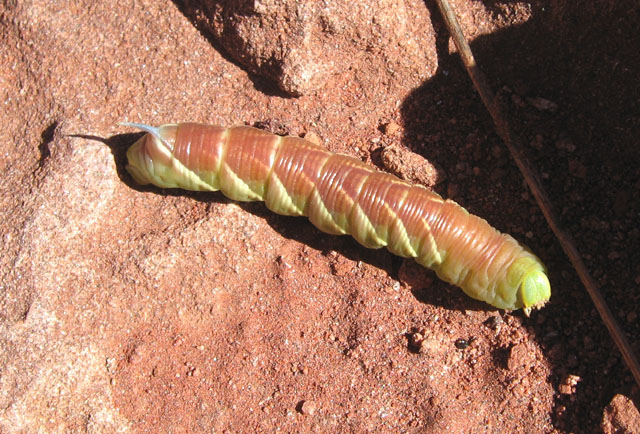Sphinginae subfamily
Sphingini tribe:
 |
Note the pinkish-orange tail (can be bluish), spiracles outlined in red and the cream
stripes on the head.
The dramatic color change from the dorsal
yellow-green to the lateral light greyish-blue is not always
as intense as in this image.
|

|
The caterpillars are called Tomato Hornworms and each has a black horn at the end of the abdomen.
Larvae feed on potato, tobacco, tomato, and other plants in the
nightshade family (Solanaceae). There is also a very beautiful brown form. See bottom of page.
|
 |
Note the green horn, raised white bumps and strong dark lines
anterior to the white ones.
|
 |
Tobacco Hornworms, equipped with a red-tipped horn at the end of the
abdomen, are true gluttons and feed on tobacco and tomato, and
occasionally potato and pepper crops and other plants in the
nightshade family (Solanaceae).
|
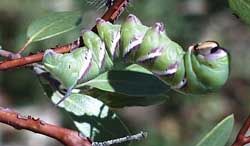 |
This species is not recorded in Wayne County, and would be unlikely.
It flies in pinyon-juniper woodland and similar arid situations in
Colorado (specimen type locality) and Nevada, Utah,
Arizona and New Mexico. |
 |
The larvae are pale bluish green. The head has a pair of yellow
lateral bands meeting at the apex.
Larval hosts are ash, lilac, privet, cherry, and quaking aspen.
|
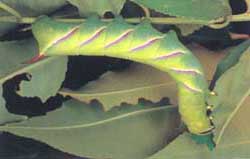 |
Sphinx drupiferarum larvae hide in the day and feed primarily on
cherry, plum, and apple at night.
Larvae have been found on Amelanchier nantuckensis in
Massachusetts and have been reared to pupation in Michigan on
Prunus serotina from eggs readily oviposited by a female.
|
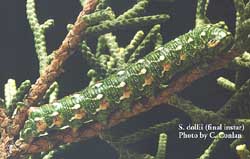 |
This species is not reported for Wayne County but may be present.
It flies in arid brushlands and desert foothills. |
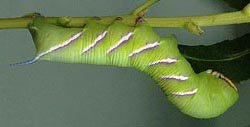 |
Sphinx perelegans
USGS, the Elegant Sphinx;
A unique feature of this larva is a shield on the first thoracic
segment, which is of the same colour as the body and which forms a
tight-fitting hood over the vertex of the head. This hides a pair of
glossy black spots on top of the head, which are revealed if the
animal is disturbed.
|
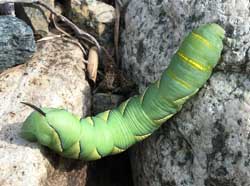 |
Sphinx vashti
USGS,
the Snowberry Sphinx
Larvae feed on the common snowberry (Symphoricarpos albus)
and on coralberry (S. orbiculatus). Note the two golden lines
of slightly raised bumps, one just behind the head, the other on the thorax.
|
Smerinthini Tribe:
 |
Pachysphinx modesta
WO,
the Modest Sphinx or Poplar Sphinx
Larvae feed on poplars and cottonwood.
|
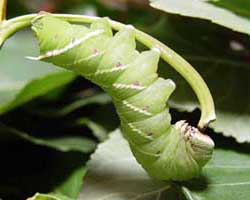 |
Larvae feed on cottonwood and poplar (Populus) and willow
(Salix).
Larvae are very chunky with little to distinguish them
from Pachysphinx modesta.
|
 |
Larvae accept willows, birches, and cherries.
I have also found them in the wild on oak in eastern Canada.
The skin of the mature larva has a very grainy appearance.
|
 |
Wild cherry species are the favorites as larval foodplants, but eggs
will also be deposited on birches and other forest trees.
There are varying degrees in the amount of red markings along the sides.
|
 |
Smerinthus cerisyi
USGS,
Cerisy's Sphinx;
Cerisyi larvae greatly resemble modesta larvae, both being pale
green, with granular skin, pale lateral diagonal lines, faint red
spiracular circles, and very pale longitudinal lines running from the
head to a more pronounced anal diagonal line.
Larvae have green heads bounded dorsally with a pale yellow
inverted "V".
|
Macroglossinae subfamily
Dilophonotini Tribe:
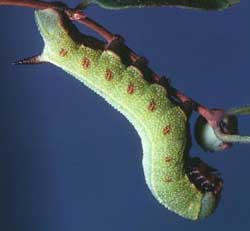 |
Larval host plants include Snowberry (Symphoricarpos),
honeysuckle (Lonicera), Coralberry, viburnums, high bush cranberry and hawthorn (Crataegus).
Horn is black with a slightly lighter base. This western species was formerly classified as
H. diffinis or H. senta. Those species west of the Continental Divide are now classified as
H. thetis.
|
 |
Hemaris senta
WO,
the Rocky Mountain Clearwing,
There is probably a single brood of this montane species from
May-August. The moth is seen along streamsides and in meadows in
mountainous areas. sorry, no larval image available; possibly same as H. thetis |
Philampelini Tribe:
 |
Larvae feed upon Grape (Vitis), Virginia Creeper
(Parthenocissus quinquefolia) and other vines and ivies
(Ampelopsis).
Larvae occur in both a light (green) form and a darker (tan/brown)
form. Note six "segmented" oblique lines.
|
Macroglossini Tribe:
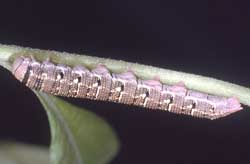 |
Euproserpinus wiesti
WO,
Wiest's Primrose Sphinx.
Euproserpinus wiesti adults fly, during the day, over sand washes
and prairie
blow-outs as a single brood from May-June. Larvae feed on prairie primrose (Oenothera latifolia) in the evening primrose family (Onagraceae).
Trying to rear in captivity has proven difficult. Larvae seem to need sunshine, heat and humidity.
|
 |
Hyles lineata
USGS, the White-lined Sphinx
Larvae are highly varied and feed on a great diversity of plants
including willow weed (Epilobium), four o'clock (Mirabilis),
apple (Malus), evening primrose (Oenothera), elm
(Ulmus), grape (Vitis), tomato (Lycopersicon),
purslane (Portulaca), and Fuschia.
All larvae seem, however, to have the red/black swellings split by
dorso-lateral lines. |
|
|
